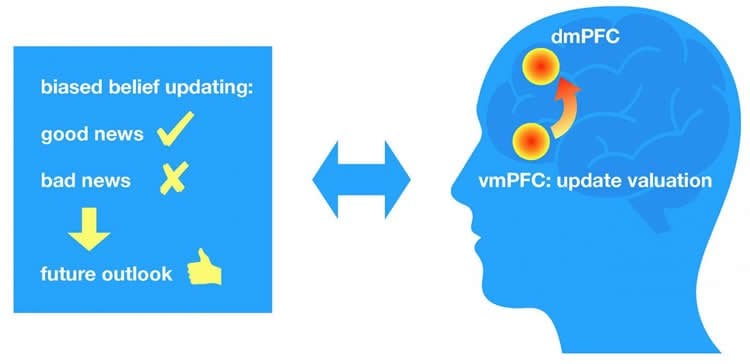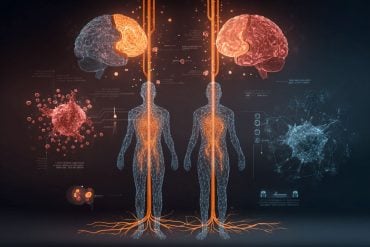Summary: Researchers report the interaction between two regions of the prefrontal cortex may underlie our motivation to cling to a desirable notion about the future.
Source: SfN.
People’s motivation to cling to desirable notions about future outlooks results from interactions between prefrontal cortex regions, according to a human neuroimaging study published in Journal of Neuroscience.
Bojana Kuzmanovic and colleagues uncovered circuits in the brain that support belief updating by asking participants to estimate their own and a peer’s likelihood of experiencing an adverse life event, such as receiving a cancer diagnosis, and then presenting them with the actual federal statistics. Participants then reevaluated their personal risk in light of this new information.
The researchers found that the difference between the two estimates was greater when participants initially overestimated their risk of the adverse event, demonstrating the well-known optimism bias. An analysis of brain activity and the underlying circuitry revealed that this phenomenon depends on the influence of the brain’s valuation system on reasoning processes.

The proposed circuit involves the dorsolateral, ventromedial, and dorsomedial prefrontal cortex, which together bias integration of new information to support a preferred conclusion.
Funding: Funding provided by Walton Family Foundation, NIH/National Institute of Child Health and Human Development, Harvard Mind Brain Behavior.
Source: David Barnstone – SfN
Publisher: Organized by NeuroscienceNews.com.
Image Source: NeuroscienceNews.com image credited to Bojana Kuzmanovic.
Original Research: Abstract for “Influence of vmPFC on dmPFC Predicts Valence-Guided Belief Formation” by Bojana Kuzmanovic, Lionel Rigoux and Marc Tittgemeyer in Journal of Neuroscience Published August 13 2018.
doi:10.1523/JNEUROSCI.0266-18.2018
[cbtabs][cbtab title=”MLA”]SfN”How the Brain Biases Beliefs.” NeuroscienceNews. NeuroscienceNews, 14 August 2018.
<https://neurosciencenews.com/biases-beliefs-9701/>.[/cbtab][cbtab title=”APA”]SfN(2018, August 14). How the Brain Biases Beliefs. NeuroscienceNews. Retrieved August 14, 2018 from https://neurosciencenews.com/biases-beliefs-9701/[/cbtab][cbtab title=”Chicago”]SfN”How the Brain Biases Beliefs.” https://neurosciencenews.com/biases-beliefs-9701/ (accessed August 14, 2018).[/cbtab][/cbtabs]
Abstract
Influence of vmPFC on dmPFC Predicts Valence-Guided Belief Formation
When updating beliefs about their future prospects, people tend to disregard bad news. By combining fMRI with computational and dynamic causal modeling, we identified neurocircuitry mechanisms underlying this optimism bias to test for valence-guided belief formation. In each trial of the fMRI task, participants (n = 24, 10 male) estimated the base rate and their risks of experiencing negative future events, were confronted with the actual base rate, and finally had the opportunity to update their initial self-related risk estimate. We demonstrated an optimism bias by revealing greater belief updates in response to good over bad news (i.e., learning that the actual base rate is lower or higher than expected), while controlling for confounds (estimation error and personal relevance of the new information). Updating was favorable when the final belief about risks improved (or at least did not worsened) relative to the initial risk estimate. This valence of updating was encoded by the ventromedial prefrontal cortex (vmPFC) associated with the valuation of rewards. Within the updating circuit, the vmPFC filtered the incoming signal in a valence-dependent manner and influenced the dorsomedial prefrontal cortex (dmPFC). Both the valence-encoding activity in the vmPFC and its influence on the dmPFC predicted individual magnitudes of the optimism bias. Our results indicate that updating was biased by the motivation to maximize desirable beliefs, mediated by the influence of the valuation system on further cognitive processing. Thus, while providing the very basis for human reasoning, belief formation is essentially distorted to promote desired conclusions.
SIGNIFICANCE STATEMENT
The question whether human reasoning is biased by desires and goals is crucial for everyday social, professional, and economic decisions. How much our belief formation is influenced by what we want to believe is, however, still debated. Our study confirms that belief updates are indeed optimistically biased. Critically, the bias depends on the recruitment of the brain valuation system and the influence of this system on neural regions involved in reasoning. These neurocircuit interactions support the notion that the motivation to maximize pleasant beliefs reinforces those cognitive processes that are most likely to yield the desired conclusion.






